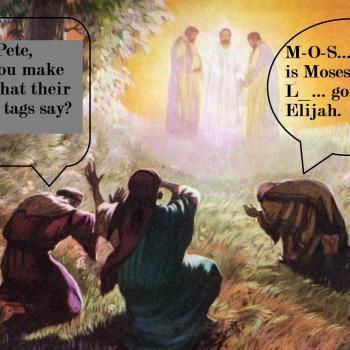The Sunday before last in my Sunday school class we talked about the two witnesses in Revelation 11. I mentioned the fact that, some years ago, I was contacted by e-mail by someone insistent that I ought to share his view on this subject with readers of my blog. His view is that the “two witnesses” were John Lennon and Paul McCartney. So I shared his e-mail, but not because I recommended anyone adopt his approach!
 We discussed some possible serious identifications. Had there not been the reference to “where their Lord was crucified” we might well have thought that Jesus was in view – and presumably he is, in the sense that the witnesses are patterned on him. If the city in question is Jerusalem, as would seem most likely, then James and Peter might be natural candidates. If one could stretch it to Rome, then Peter and Paul might seem more likely. Any proposed identification depends as well on whether the figures were past, present, or future from the author’s perspective.
We discussed some possible serious identifications. Had there not been the reference to “where their Lord was crucified” we might well have thought that Jesus was in view – and presumably he is, in the sense that the witnesses are patterned on him. If the city in question is Jerusalem, as would seem most likely, then James and Peter might be natural candidates. If one could stretch it to Rome, then Peter and Paul might seem more likely. Any proposed identification depends as well on whether the figures were past, present, or future from the author’s perspective.
The issue of chronology comes up again in chapter 12, where we encounter a woman and a child, the identities of which have been debated in similar fashion. The woman has sometimes been identified as Mary, but that seems to propose a level of development of Mariology otherwise unknown at this stage. She could be Eve, with Abel and other righteous descendants being traced to her, or she could be a symbol of the people of Israel. The dragon that represents the devil is particularly fascinating, since it closely resembles Tiamat (the Babylonian equivalent of the Greek Hydra), including the connection with water. And so there are deep mythological roots here.
 If nothing else, chapter 12 indicates that the Book of Revelation simply cannot be treated as intended to depict a series of events in chronological order. There does not seem to be any possible identification of the child to whom the woman gives birth that would not be chronologically prior to the author’s time and to the events the book has already depicted as expected in the future.
If nothing else, chapter 12 indicates that the Book of Revelation simply cannot be treated as intended to depict a series of events in chronological order. There does not seem to be any possible identification of the child to whom the woman gives birth that would not be chronologically prior to the author’s time and to the events the book has already depicted as expected in the future.
The idea of the devil being cast down from heaven likewise raises interesting chronological questions. Has the devil been cast down and then restored more than once? Did the author view the devil as a fallen angel whose fall occurred prior to or soon after the creation of humanity? Did the author know of Jesus’ statement about having seen Satan fall like lightning from heaven, and if so did he consider it something that happened in Jesus’ time or as something yet to occur?
Chapter 12 also raises interesting questions for those who say that they interpret the text “literally.” Do they really think that the devil is a dragon that spews water? Do those who take that stance think that Mary (it must be a literal woman, right?) stood on the moon?
But these two chapters raise puzzles for the preterists and anyone who treats the text as related to the author’s own time, and considers the text to have been meant to be intelligible to its earliest readers, just as they present puzzles for other approaches to Revelation. Who were the witnesses, the woman, and the child? What would the earliest readers have understood these references to denote?
What, if anything, do readers of this blog understand these texts to be talking about?












